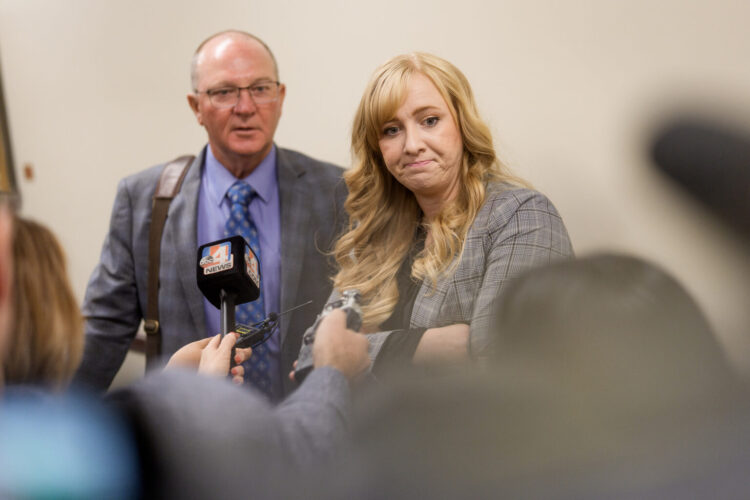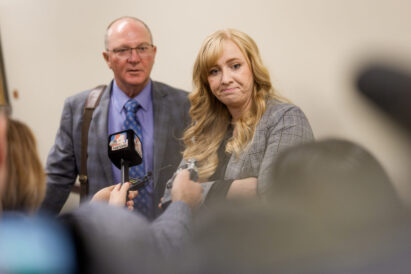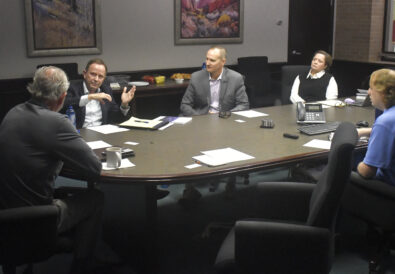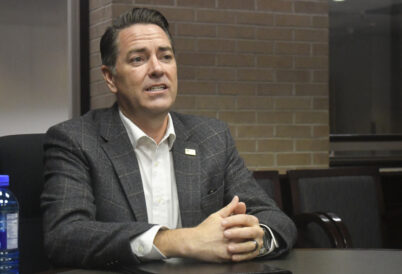Utah lawmakers and plaintiffs accuse each other of gerrymandering with dueling redistricting experts
Utah lawmakers and plaintiffs accuse each other of gerrymandering with dueling redistricting experts Unanswered legal questions abound as Utah’s court-ordered redistricting process gets muddied by Utah Republican Party’s map referendum and indirect initiative, which plaintiffs argue shouldn’t have the power to trump Proposition 4

Spenser Heaps for Utah News Dispatch
Sen. Scott Sandal, R-Tremonton, and Rep. Candice Pierucci, R-Riverton, talk to reporters after a meeting of the Utah Legislative Redistricting Committee during a special legislative session at the Capitol in Salt Lake City on Monday, Oct. 6, 2025.The legal battle over Utah’s redistricting process and what congressional boundaries should be used for the 2026 election is reaching a new fever pitch — with more complexity and uncertainty than ever.
As a Nov. 10 deadline looms for 3rd District Judge Dianna Gibson to pick a new congressional map, a flurry of court filings have flooded her court docket over the past week. On Thursday and Friday, she’s scheduled two days of evidentiary hearings.
In the filings, legislative attorneys and plaintiffs in the state’s ongoing court-ordered redistricting process argue over their preferred maps, their dueling redistricting experts, and what statistical tools should — and shouldn’t — be used to determine partisan slants or gerrymandering. Both sides are calling each other’s maps partisan gerrymanders.
Meanwhile, uncharted legal waters are becoming increasingly murky as the Utah Republican Party mounts an effort to both block the map the GOP-controlled Utah Legislature advanced earlier this month (which the party also encouraged Republicans to support as the least damaging option) — and pursue what’s called an “indirect initiative” to overturn the state’s independent redistricting law.
If successful, that indirect initiative could force lawmakers to take an up or down vote on repealing Proposition 4, the 2018 voter-approved law that requires an independent redistricting process, which the courts recently deemed is now the law after determining the 2021 Utah Legislature acted unconstitutionally when it undid it to draw the map adopted that year.
Legal fight over indirect initiative
The lawsuit’s plaintiffs are urging Gibson not to pick the Legislature’s chosen 2025 map, known as map C, pointing to expert analysis alleging it “favors Republicans and disfavors Democrats to an extreme degree.” Meanwhile, plaintiffs are also asking the judge to block the GOP’s indirect initiative, arguing that even if they succeed in gathering the required 70,374 signatures by Nov. 14, an indirect initiative doesn’t have the power to unravel what more than half a million voters supported and enacted in 2018.
“A mere 4% of voters (70,374) cannot convert an unconstitutional legislative repeal of Proposition 4 into a constitutional one through a vehicle — the indirect initiative — with no constitutional genesis,” plaintiffs’ attorneys wrote. “To conclude otherwise would be to allow the Legislature (to) enact by a statute a mechanism to violate the People’s constitutional rights.”
The Legislature’s attorneys, on the other hand, argue that both of the alternative maps plaintiffs have submitted to the court are partisan gerrymanders.
“At best, (the plaintiffs’) plans are not as fair as the 2025 (map) and, at worst, their plans are themselves purposeful partisan gerrymanders,” legislative attorneys wrote, adding that the upcoming evidentiary hearing later this week, scheduled for Thursday and Friday, “will confirm why the 2025 (map) is lawful and Plaintiffs’ proposals are extreme partisan outliers.”
Plaintiffs have also filed another complaint asking Gibson to block a companion law legislators passed alongside their 2025 maps that requires three specific tests to determine whether a congressional map unduly favors or disfavors a political party.
Plaintiffs allege those tests were “cherry picked” to “infect” Proposition 4 with methods that will favor majority parties in states like Utah that have a dominant majority party. Legislative attorneys, however, argue the tests have merit, and were the result of legislators’ “good-faith effort” to clarify “vague” terms in Proposition 4 and exercise their discretion to determine which tests would be best to use.
What could happen next?
Each outstanding legal question could have major implications for Utah’s court-ordered redistricting process.
If Gibson picks the Legislature’s map C, but the Utah GOP’s application for the citizen referendum on the map is successful, that could leave the state in limbo with a big question mark over which map would govern the 2026 elections, since the courts have already voided the 2021 map as the result of an unconstitutional process.
To successfully put the map referendum on the ballot, the party must gather more than 140,000 valid signatures (or 8% of the number of active voters statewide and in 15 of the 29 Senate districts) in 30 days, but no later than Nov. 15. Clerks will have 21 days to verify signatures, but voters will also be allowed up to 30 days to remove their signatures.
If the referendum application qualifies for the ballot, the lieutenant governor would block the map from being used in the 2026 election, until voters could weigh in.
However, the party’s signature gathering window wouldn’t end until after Nov. 10, which Utah’s top election officials have said is the latest possible deadline to give county clerks time to set their precincts ahead of the 2026 elections.
If Gibson picks one of the plaintiffs maps? Republican lawmakers have already indicated they’ll fight the decision tooth and nail, arguing there’s nothing in the Utah Constitution that allows a judge to pick a map over one drawn by lawmakers. The plaintiffs, however, argue redistricting cases in other states set a strong legal precedent for a judge to pick remedial maps when legislators fail to follow the law.
There’s also legal uncertainty around the indirect initiative.
If the Republican Party’s effort succeeds, that could push the Utah Legislature to repeal Proposition 4 and its independent redistricting commission — but likely not until lawmakers’ 2026 general session begins in January, well past the Nov. 10 deadline to set a 2026 map.
And it remains to be seen whether the judge agrees with plaintiffs that an indirect initiative can’t trump a voter-approved ballot initiative.
Dueling redistricting expert reports
In addition to sorting through these legal questions, Gibson must also wade through hundreds of pages of dueling analyses from redistricting experts retained by both the Legislature and the plaintiffs.
Their slate of experts are at odds over which maps are fair and which statistical methods are best suited for a politically “lopsided” state like Utah with only four congressional districts.
For the Legislature, three experts have filed declarations: Michael Barber, political science professor at Brigham Young University and director of the Center for the Study of Elections and Democracy; Sean Trende, senior elections analyst for Real Clear Politics; and Jonathan Katz, professor of social sciences and statistics at the California Institute of Technology.
The plaintiffs have retained the following experts: Chris Warshaw, a professor at the McCourt School of Public Policy at Georgetown University; Jowei Chen, an associate professor in the Department of Political Science at the University of Michigan, Ann Arbor; and Kassra Oskooii, an associate political science and international relations professor at the University of Delaware.
Pointing to Chen’s expert analysis, which compared map C with 10,000 computer-simulated maps, plaintiffs wrote it showed that “over 99.9% of simulations create one Democratic-leaning district including northern Salt Lake County, and three Republican-majority districts – reflective of Utah’s political geography and makeup.”
“By contrast, Map C cracks Salt Lake County’s Democratic voters in half creating four safe Republican districts, a result almost never observed among neutral simulations programmed to follow Prop 4’s neutral criteria,” they wrote. “Map C is thus an extreme outlier and exhibits a ‘statistically significant degree of electoral bias in favor of the Republican Party.'”
The plaintiffs also argued Chen’s report showed Trende’s methods to assess map C’s partisan intent was “deeply flawed” and was “infected with partisan bias from start to finish.”
Trende, in his declaration, defended his methods while arguing that Proposition 4 “clearly, in my view, forces the legislature to adopt partisan bias as one of its standards, as it is the only standard that truly measures symmetry.”
“Plaintiffs suggest that I have cherry-picked the standards that Utah could meet in order to enable a Republican gerrymander,” Trende wrote. “To be clear, this is false. I employed partisan bias because I believe Prop. 4 mandates its use.”
Trende also disputed claims that he drew maps with the “purpose and intent of favoring Republicans and disfavoring Democrats,” calling them “untrue.” He said the final maps considered by lawmakers were based on maps drawn by computers. “Not only were they not drawn with partisan intent; they were drawn by machines deprived of any partisan information.”
Additionally, Trende wrote that map C creates “two districts that are more Democratic than a very competitive district from the prior decade which is inconsistent with any claim of a ‘free-rein’ Republican gerrymander.”
“In short,” Trende wrote, “Plaintiffs seek to replace a map with two competitive districts with one engineered to contain one safely Democratic district.”
In contrast, Chen’s analysis said map C’s “creation of four Republican-favoring districts clearly goes well beyond any ‘natural’ level of electoral bias caused by Utah’s political geography or the political composition of the state’s voters because Map C is such an extreme statistical outlier in terms of its partisan characteristics when compared to the 10,000 computer-simulated plans.”
“It creates more Republican-favoring districts than 99.94% of the simulated plans,” Chen wrote. “This extreme, additional level of partisan bias in Map C did not follow from Utah’s political geography and can be directly attributed to the map-drawer’s efforts to favor the Republican Party.”
Utah News Dispatch is part of States Newsroom, the nation’s largest state-focused nonprofit news organization.



